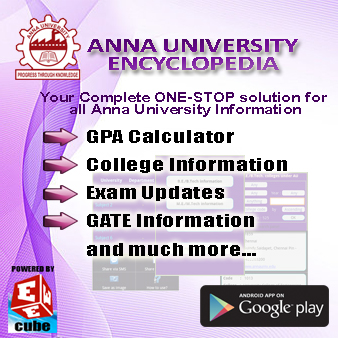SUBJECT RESOURCES:
CLICK HERE to access 'Previous Year Question Papers'
CLICK HERE to access 'Question Banks'
CLICK HERE to access '2 Marks'
CLICK HERE to search more about this subject
SYLLABUS:
CLICK HERE to access 'Previous Year Question Papers'
CLICK HERE to access 'Question Banks'
CLICK HERE to access '2 Marks'
CLICK HERE to search more about this subject
SYLLABUS:
EE 2403 SPECIAL ELECTRICAL MACHINES L T P C
3 0 0 3
AIM
To
expose the students to the construction, principle of operation and performance of special
electrical
machines as an extension to the study of basic electrical machines.
OBJECTIVES
To impart knowledge on
i. Construction, principle of operation and performance of synchronous reluctance motors.
ii. Construction, principle of operation, control and performance of stepping motors.
iii. Construction, principle of operation, control and performance of switched reluctance motors.
iv. Construction, principle of operation, control and performance of permanent magnet brushless
D.C. motors.
v. Construction, principle of operation and performance of permanent magnet synchronous motors.
UNIT I SYNCHRONOUS RELUCTANCE MOTORS 9
Constructional features – Types – Axial and Radial flux motors – Operating principles – Variable
Reluctance and Hybrid Motors – SYNREL Motors – Voltage and Torque Equations -
Phasor diagram
- Characteristics.
UNIT II STEPPING MOTORS 9
Constructional features – Principle of operation – Variable reluctance motor
– Hybrid motor – Single and multi
stack configurations – Torque equations – Modes of excitations – Characteristics – Drive circuits – Microprocessor control of stepping motors – Closed loop control.
UNIT III SWITCHED RELUCTANCE MOTORS 9
Constructional features – Rotary and Linear SRMs - Principle of operation – Torque production –
Steady state performance prediction- Analytical method -Power Converters and their controllers – Methods of
Rotor
position
sensing
–
Sensorless
operation
–
Closed loop
control of
SRM - Characteristics.
UNIT IV PERMANENT MAGNET BRUSHLESS D.C. MOTORS 9
Permanent Magnet materials – Magnetic Characteristics
– Permeance coefficient -Principle of
operation – Types – Magnetic circuit analysis – EMF and torque equations –Commutation -
Power controllers – Motor
characteristics and control.
UNIT V PERMANENT MAGNET SYNCHRONOUS MOTORS 9
Principle of operation – Ideal PMSM
– EMF and Torque equations – Armature reaction MMF – Synchronous Reactance –
Sinewave motor with practical windings -
Phasor diagram
–
Torque/speed characteristics - Power controllers - Converter Volt-ampere requirements.
TOTAL : 45 PERIODS
TEXT BOOKS:
1. T.J.E. Miller, ‘Brushless Permanent Magnet and Reluctance Motor Drives’, Clarendon Press, Oxford, 1989.
2. T. Kenjo, ‘Stepping Motors and Their Microprocessor Controls’, Clarendon Press London, 1984.
REFERENCES:
1. R.Krishnan, ‘Switched Reluctance Motor Drives – Modeling, Simulation, Analysis, Design and
Application’, CRC Press, New York, 2001.
2. P.P. Aearnley, ‘Stepping Motors – A Guide to Motor
Theory and Practice’, Peter Perengrinus
London, 1982.
3. T. Kenjo and S. Nagamori, ‘Permanent Magnet and Brushless DC Motors’, Clarendon Press, London, 1988.
|
|










No comments:
Post a Comment
Note: Only a member of this blog may post a comment.